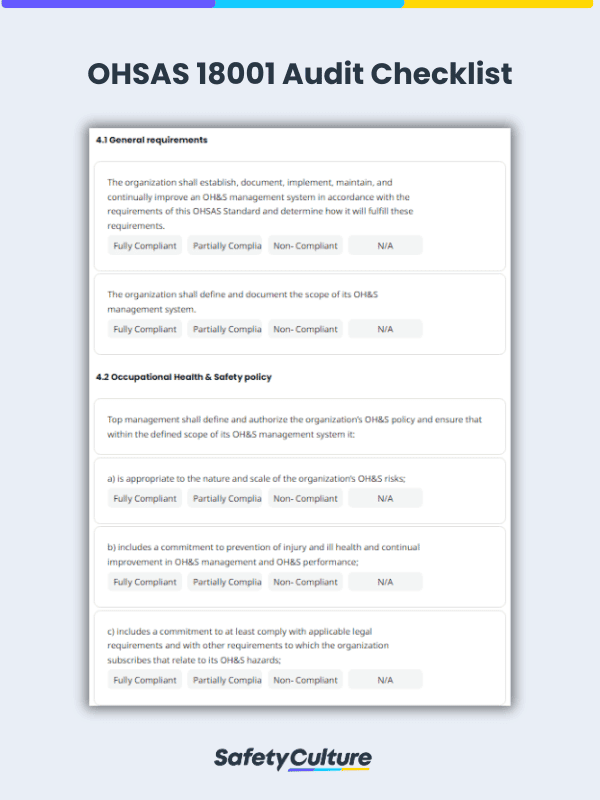What is OHSAS 18001?
The Occupational Health and Safety Assessment Series (OHSAS) 18001:2007 is an international standard for occupational health and safety management systems. It ensures that a framework is in place to proactively identify and address health and safety risks in the workplace, helping promote a safe working environment and reduce the possibility of work-related incidents.
What is an OHSAS 18001 Audit Checklist?
An OHSAS 18001 audit checklist is a tool used by safety officers to confirm if an organization’s existing occupational health and safety (OH&S) management system is aligned with the OHSAS 18001 standard. It is used to assess the organization’s readiness for third-party certification.
Highlights of an OHSAS 18001 Checklist
Derived from the OHSAS 18001:2007 standard’s OH&S management system requirements, an OHSAS checklist is used to confirm the following main points:
Planning of OH&S
The OHSAS audit checklist aims to confirm if the organization conducted hazard identification and risk assessment to determine safety controls to be implemented in the workplace. It also seeks to confirm if the OH&S management system’s scope is defined and in accordance with the standard.
Implementation of OH&S
The checklist intends to confirm if the organization’s top management is responsible for the implementation of OH&S and if the organization is conducting and documenting monitoring procedures such as internal audits to measure the effectiveness of OH&S.
Continuous improvement of OH&S
The OHSAS checklist aims to confirm if top management is reviewing the results of the internal audits to discover areas for improvement to work on as part of the continuous improvement of OH&S.
Benefits of Getting Certified
Getting certified for an OHSAS 18001 can bring numerous benefits to the organization. Some of which are the following:
Zero Accidents
OHSAS 18001 guides organizations in reducing work incidents by providing a system for identifying and managing occupational health and safety hazards. It also provides tools and techniques for minimizing health and safety risks and improving employee awareness. Investigations are done more efficiently and effectively. Therefore reducing the likelihood of incidents or accidents from occuring due to better control over risks and regular performance monitoring.
Legal Compliance
OHSAS 18001 helps the organization establish and maintain compliance by providing frameworks that can be used for identifying, monitoring and complying with relevant legal, regulatory, and contractual requirements.
Reduce Operating Costs
All costs associated with downtime due to accidents and incidents are reduced. Legal fines and prosecutions from non-compliance are also avoided.
Boosts Credibility and Brand Image
The adoption of best practices for occupational health and safety through OHSAS 18001 improves the organization’s image and credibility among stakeholders, regulators, customers, clients (existing and potential), and the general public. It gives the organization a competitive advantage in the industry and becomes even more trustworthy and valuable.
Continuous Improvement
OHSAS 18001 mainly aims to assist organizations to have continuous improvement in all aspects of the operation. Implementing the standards of OHSAS 18001 enhances workplace morale and productivity.
What is the difference between OHSAS 18001 and ISO 45001?
According to the International Organization for Standardization or ISO, one of the main differences between the two standards is their focus. OHSAS 18001 focused on managing occupational hazards and other internal issues. Meanwhile, ISO 45001 widens its scope by including the interaction between the organization and its business environment.
OHSAS 18001 has officially been replaced by ISO 45001.
- Read more information on implementing ISO 45001 here.
- Explore ISO 45001 checklists here.


